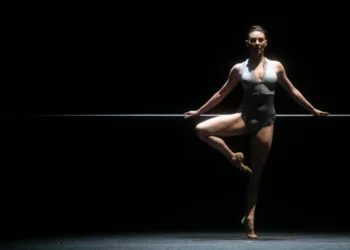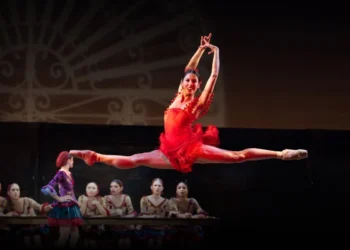La Scala Theatre Ballet Gala Fracci Review
May 15, 2025 | Teatro alla Scala – Milan, Italy
On Thursday, May 15th, Teatro alla Scala presented the fourth edition of Gala Fracci, a tribute to one of ballet’s most beloved figures: Carla Fracci. This year’s gala, under the direction of Frédéric Olivieri, featured pieces that have been directly shaped and influenced by Fracci’s iconic interpretations:
- Jean Coralli and Jules Perrot’s Giselle
- Rudolf Nureyev’s Don Quixote
- Ronald Hynd’s The Merry Widow
- John Cranko’s Onegin and Romeo & Juliet
- Mario Pistoni’s La Strada
- Marius Petipa’s Sleeping Beauty
Preceding the Gala Fracci, Angelo Bonello’s new installation, Art Is, was unveiled in Piazza della Scala. This digital mosaic features about 100 video interviews in which artists, ballet dancers, art curators, photographers, gallerists, musicians, choreographers, architects and composers shared their personal reflections on what art means to them.
The first video showed was an interview with Fracci herself in which she expressed,
“Humans have a relationship with art, either as creators or those who experience and appreciate it.”
It was a statement that foreshadowed a night in which all those that participated reflected continuously on her words.
Carla Fracci began her ballet career in the 1950s at La Scala, where she trained under renowned instructors such as Esmée Bulnes and Vera Volkova, eventually rising to the rank of Principal Dancer at La Scala. She later embarked on an international career performing on the world’s most prestigious stages.
Fracci played a pivotal role in shaping ballet culture in Italy and was honored with numerous accolades that reflected her widespread influence across various pillars of art.
You may also like...
Turn It Out With Tiler Peck & Friends Review: A Prima, Making It All Happen
As curator of Turn It Out With Tiler Peck & Friends - and together with her stellar retinue - Peck puts on a show that not only inspires but also proclaims how she is setting a new standard in the...
Philadelphia Ballet Carmen and Boléro Review
Philadelphia Ballet Carmen and Boléro Review: This double bill requires full-bodied expression and unrestrained control – only a company willing to commit fully can execute it successfully.
La Scala Theatre Ballet Gala Fracci Review
The tribute gala was performed by La Scala Corps, the Soloists, the Principal Dancers and guest dancers Marianela Nuñez and Reece Clarke of The Royal Ballet, while the Scala Orchestra was conducted by Valery Ovsyanikov.
Prefacing each piece, a projected photograph of Fracci in the corresponding role was shown on stage offering a visual thread that served as a reminder of her lasting influence on the respective works.

The gala began with a défilé, a joyful opening that showcased the young talents of the school and entirety of the company. It was surely a moment to disclose the kind of wide acknowledgement and inspiration still maintained in La Scala Ballet for Fracci.
Following the défilé was the first nod to Fracci in the pas de deux of the second act of Giselle, featuring Martina Arduino and Marco Agostino. Arduino, who had the opportunity to attend some of Fracci’s final classes, captured the essence of the Giselle that Fracci so memorably brought to life years earlier.
During the Grand Pas de Deux from Act III of Don Quixote, performed by Alice Mariani, Nicola Del Freo and Maria Celeste Losa, the audience responded with palpable enthusiasm.
Del Freo, in particular, received an especially warm applause for his energetic execution.

Nuñez performed in Act III of The Merry Widow and subsequently in the role of Aurora in the Rose Adage of The Sleeping Beauty, offering unmatched skill, control and precision in all of her performances.
Leading up to the Gala Fracci Tribute, Ronald Hynd, the original choreographer of The Merry Widow, oversaw and guided some practices of the La Scala Corps, as well as the performances of Nuñez, Clarke, Virna Toppi, Mattia Semperboni, Gabriele Corrado and Massimo Garon.
The Merry Widow, known for its comical plot and charismatic choreography, captivated the audience, despite a few minor missteps that occurred onstage.
Nuñez’s performance was especially notable in her execution of Aurora, a notoriously challenging role demanding impeccable balance while dancing with each of the four suitors.
Nuñez demonstrated expertise in her seemingly easy execution of the piece that left the audience awestruck.
The excerpt from La Strada showcased an entertaining role that was created for Carla Fracci, who danced in the ballet’s premiere in 1974 with the choreographer himself, Mario Pistoni; this evening’s interpretation featured La Scala’s Antonella Albano and Christian Fagetti.
The tribute concluded with the pas de deux from Act II and grand finale of Excelsior, a jubilant celebration brought to life by La Scala’s beloved primi, Nicoletta Manni and Timofej Andrijashenko, joined by the full company and students.
Before the curtain fell, the dancers turned their backs to the audience to face one last projection of Italy’s ballet sweetheart and initiate a heartfelt round of applause in honor of Carla Fracci, echoing her words from the Art Is installation and reminding all present of her enduring legacy.
Featured Photo of La Scala Theatre Ballet’s Nicoletta Manni and Timofej Andrijashenko in Luigi Manzotti’s Excelsior. Photo by Brescia-Amisano © Teatro all Scala.












